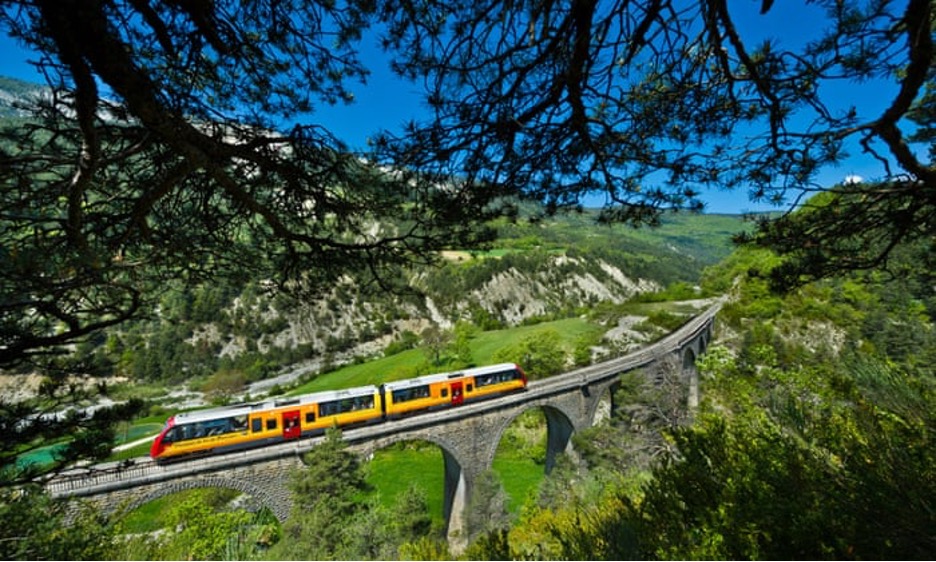Twenty-five European intercity journeys where you should consider traveling by train instead of plane.

Europe’s train system, particularly for intra-country travel, is a well-developed and affordable option for travelers visiting the region. If you already live in Europe, it can be a very easy way to travel without flying. You won’t have to deal with long airport security lines, airport commute hassles, luggage fees, or a host of other problems. Instead, you can hop on a long-distance train from the center of virtually any major European city to reach your final destination.
European trains often offer some complimentary conveniences: they give you the freedom to stretch your legs, or stroll to a dining car for something to eat or drink. Not to mention, trains rarely come with the problems that many European airports and airlines have faced over the last few summers.
Why you should take the train
Although traveling by train can sometimes take longer than flying, the benefits of slow travel shouldn’t be overlooked. By taking a rail journey instead of hopping on a plane, you can eschew much of the stress associated with airports and security. Also, in many instances — if you plan properly and buy the correct fares — you’ll get to see multiple destinations on one trip.
Sure, occasionally, flying might be the cheapest option, but it’s not always the most rewarding. Plus, with rail travel in Europe growing more and more popular, we regularly see great deals on travel that dwarf the prices offered on even low-cost carriers. Here are five benefits of taking a train around Europe.
1. No security and customs screening lines
Simply walking on and off trains with your luggage in hand is a time-saving luxury that air travelers haven’t experienced for decades. The airport security screening process and sprawling lines at passport control and customs can add hours to the experience. As a result, what you had hoped would be a quick flight may feel more time-consuming (and exhausting) than traveling by train.
2. Free internet access
Many airlines don’t provide Wi-Fi (especially budget ones), and they often charge a high price if they do. Most long-distance European trains come with Wi-Fi included in the ticket price. Additionally, you’ll have much more legroom and tray table space to work on a train once you’re connected.
3. No airport commute hassle
Taking a train from the central station of your favorite European city is typically far more convenient than schlepping outside the city to an airport. This is especially true if you’re staying in or near the city center. Depending on where you stay, you may even find it possible to walk directly to or from the station or reach the main station easily via (cheap) public transport.
4. Fewer cancellations and delays
European trains are not subject to the same weather and air traffic control delays as airplanes and they have much more consistent schedules. Some overnight trains and those with longer, more complicated itineraries may have delays on the rails to make way for overnight freight traffic; however, in comparison to planes, delays are often less likely or impactful.
5. Less environmental impact
You may not regularly think about how environmentally friendly your trips are, but it doesn’t mean your travels don’t play a part in the larger conversation about the environment. Many experts agree there is a substantial environmental benefit to traveling by train instead of flying. For example, journey from London to Paris by air is estimated to emit around 10 times as much CO2 as the same journey by rail.
25 best European train routes
Trains departing from Austria
*Vienna to Paris
Launched in 2021, this Nightjet sleeper train route runs three times a week and takes around 14 hours to go straight through from Vienna to Paris. It has notable stops along the way, including Munich and Strasbourg, France.
*Vienna to Genoa and La Spezia
This is an extension of Nightjet’s service from Vienna/Munich to Milan. The route runs daily and takes around 16 hours to go all the way to La Spezia in Italy, passing through Milan and Genoa en route. You can book tickets for both routes on the Nightjet website.
Trains departing from Belgium
*Brussels to Berlin
European Sleeper launched in 2021, and one of its first routes was the overnight service from Brussels to Berlin. The route stops off at Antwerp, Belgium, before heading through the Netherlands. There, you can hop off at Rotterdam, Amsterdam, or Deventer if you’re not looking to travel all the way to Berlin. You can book tickets on the European Sleeper website.
*Liege to Aachen and Maastricht
This route is a collaboration between Arriva, SNCB (the National Railway Company of Belgium), and Nederlandse Spoorwegen. It will connect Belgium, Germany, and the Netherlands.
*Brussels to Dresden and Prague
European Sleeper has additional stops in Dresden, Germany, and Prague.
Trains departing from the Czech Republic
*Prague to Zurich
This route is operated by the Czech Republic’s national rail operator Ceske drahy. The full overnight journey takes less than 14 hours and passes through Frankfurt and Basel, Switzerland. You can book tickets on the official website.
Trains departing from France
*Paris to London
Perhaps one of Europe’s most famed train routes, Eurostar travels between London St Pancras station and Paris Gare du Nord station in just more than two hours. Services run almost hourly, seven days a week. You can book tickets on the Eurostar website.
*Paris to Berlin
Following a partnership between German rail operators Deutsche Bahn and France’s SNCF, this high-speed TGV service stops in Strasbourg on the night run. The door-to-door journey takes about seven hours.
*Paris to Venice
This sleeper link between two of Europe’s most romantic cities is operated by French rail company Midnight Trains. It also stops in Milan.
Trains departing from Germany
*Berlin to Stockholm
This was formerly Swedish rail company Snalltaget’s service from Berlin to Malmo, Sweden. Now, this route has been extended all the way to Stockholm; it passes through Hamburg, Germany, and Denmark before reaching its final destination. The full journey takes just less than 17 hours and is a direct service. You can book tickets on the Snalltaget website.
*Stuttgart to Zagreb and Rijeka
Another epic sleeper train from Nightjet (this time under its EuroNight partnerships) allows you to easily ride from Germany to Croatia on two different routes. Both routes start in Stuttgart, Germany, and pass through Munich. One route ends in the Croatian capital Zagreb, and the other heads to the Croatian harbor of Rijeka. The trips take 14 and 15 hours, respectively. However, note that the Rijeka route is seasonal and finishes at the end of September. Trains to Zagreb, however, run daily throughout the year.
You can book tickets for both routes on the Nightjet website.
*Berlin to Brussels
This route is mentioned above under “Brussels to Berlin.” You can book tickets on the European Sleeper website.
*Munich to Genoa and La Spezia
This route extends the above-mentioned route under “Vienna to Genoa and La Spezia.” You can book tickets for both routes on the Nightjet website.
*Aachen to Liege and Maastricht
This route is referenced above under “Liege to Aachen and Maastricht.”
Trains departing from Italy
*Milan to Paris
This speedy route, operated by Frecciarossa (part of the Italian national train company Trenitalia), will take you between two of Europe’s most fashionable cities in just less than seven hours. If you don’t want to go the full stretch, you can also hop off at Turin, Italy, or Lyon, France. The service operates almost hourly every day. You can book tickets on the Trenitalia website.
*Intercity travel around Italy with Trenitalia
Italy’s national rail network is a great way to get around the country and escape airport hassles. The Trenitalia Pass is an affordable and flexible option to use as you travel from one Italian destination to the next. You can book several trips within a seven-, 15- or 30-day period for as little as $128. If you don’t want to commit to buying a pass, you can instead purchase individual tickets from Trenitalia. Fares for its popular route connecting Rome and Florence, Italy—which takes a little more than 1 1/2 hours—cost less than $60 per person round-trip.
Trains departing from the Netherlands
*Amsterdam to Austria
Tui’s “Ski Express” is a special winter service that operates every Friday night between Dec. 23 and March 31. It allows ski fanatics to hop between Amsterdam and the Austrian Alps’ famed ski resorts, such as Gerlos, Kirchberg, Niederau, Soll, Zell am See, and Westendorf. You can book tickets on the Tui website.
*Amsterdam to Zurich
Another Nightjet train, this route can whisk you between Amsterdam and Zurich in roughly 12 hours. It passes through Utrecht, Netherlands, and Cologne, Germany, along the way. The train runs daily from 8 p.m. and arrives at its destination the following day at 8 p.m. You can book tickets for both routes on the Nightjet website.
*Maastricht to Aachen and Liege
This route is covered above under “Liege to Aachen and Maastricht.”
*Amsterdam to Barcelona
This European Sleeper route takes approximately 17 hours. It stops at Rotterdam, Netherlands; Antwerp, Belgium; Brussels; Lille, France; Avignon, France; Montpellier, France; and Girona, Spain, among others. You can book tickets on the European Sleeper website.
Trains departing from Spain
*Madrid to Marseille via Barcelona
The eight-hour route from Madrid to Marseille, France, by Renfe connects 14 destinations across Spain and France, including Barcelona; Figueres, Spain; Montpellier, France; Nimes, France; and Aix-en-Provence, France, before its final stop at Marseille. You can book tickets for both routes on the Renfe website.
*Barcelona to Lyon
Along with the above route, Renfe also connects Barcelona to Lyon, with stops in Girona, Spain; Perpignan, France; Montpellier, France; Nimes, France; and Valence, France. The route takes around five hours if you stay aboard until the final stop. You can book tickets for both routes on the Renfe website.
Trains departing from Slovenia
*Ljubljana to Budapest
One of the most affordable routes on this list, these tickets regularly cost as little as 16 euros (about $17). Operated by Hungarian Railways, the train travels from Slovenia via Graz, Austria, before its final destination of Budapest. You can book tickets on the operator’s official website.
Trains departing from Sweden
*Stockholm to Hamburg
This daily service operated by SJ EuroNight will take you from Stockholm to Hamburg via Copenhagen. It departs at 5:30 p.m. and arrives at 6:30 a.m. the following day. Plush compartments are available — including some for one to three people, complete with a private shower. The train also has pet-friendly compartments should you wish to travel with your beloved pooch. You can book tickets on the SJ website.
Trains departing from the UK
*London to Amsterdam, Brussels, Paris and the French Alps
Taking Eurostar from central London is a speedy and efficient way of traveling to Europe without the hassle of taking a plane. Starting at London St. Pancras station, you’ll travel through the Channel Tunnel, which connects the continent to the U.K. with various destinations and routes. London to Amsterdam’s city center takes less than four hours to complete. Round-trip tickets start around $80 per person, a reasonable price given how expensive taxi rides to Heathrow from downtown London can be on a busy day. Traveling to Brussels from London St Pancras is just as easy and takes less than two hours with similarly low prices.
As mentioned above, under “Paris to London,” you can also reach the French capital in just over two hours. Beyond Paris, between December 16 and December 3, you’ll also be able to travel from London to the French Alps to visit various ski resorts in Chambery, Albertville, Moutiers, Aime-la-Plagne, and Bourg-Saint-Maurice. You can book tickets on the Eurostar website.
Twist’s Take: Rather than worry about flight delays and cancellations, lost luggage, long customs lines, and more, consider taking an environmentally-friendly intercity train trip.
